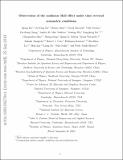| dc.contributor.author | Ma, Qiong | |
| dc.contributor.author | Xu, Su-Yang | |
| dc.contributor.author | Shen, Huitao | |
| dc.contributor.author | MacNeill, David | |
| dc.contributor.author | Fatemi, Valla | |
| dc.contributor.author | Chang, Tay-Rong | |
| dc.contributor.author | Mier Valdivia, Andrés M. | |
| dc.contributor.author | Wu, Sanfeng | |
| dc.contributor.author | Du, Zongzheng | |
| dc.contributor.author | Hsu, Chuang-Han | |
| dc.contributor.author | Fang, Shiang | |
| dc.contributor.author | Gibson, Quinn D. | |
| dc.contributor.author | Watanabe, Kenji | |
| dc.contributor.author | Taniguchi, Takashi | |
| dc.contributor.author | Cava, Robert J. | |
| dc.contributor.author | Kaxiras, Efthimios | |
| dc.contributor.author | Lu, Hai-Zhou | |
| dc.contributor.author | Lin, Hsin | |
| dc.contributor.author | Fu, Liang | |
| dc.contributor.author | Gedik, Nuh | |
| dc.contributor.author | Jarillo-Herrero, Pablo | |
| dc.date.accessioned | 2020-04-30T19:36:30Z | |
| dc.date.available | 2020-04-30T19:36:30Z | |
| dc.date.issued | 2018-12 | |
| dc.date.submitted | 2018-07 | |
| dc.identifier.issn | 0028-0836 | |
| dc.identifier.issn | 1476-4687 | |
| dc.identifier.uri | https://hdl.handle.net/1721.1/124951 | |
| dc.description.abstract | The electrical Hall effect is the production, upon the application of an electric field, of a transverse voltage under an out-of-plane magnetic field. Studies of the Hall effect have led to important breakthroughs, including the discoveries of Berry curvature and topological Chern invariants. The internal magnetization of magnets means that the electrical Hall effect can occur in the absence of an external magnetic field; this ‘anomalous’ Hall effect is important for the study of quantum magnets. The electrical Hall effect has rarely been studied in non-magnetic materials without external magnetic fields, owing to the constraint of time-reversal symmetry. However, only in the linear response regime—when the Hall voltage is linearly proportional to the external electric field—does the Hall effect identically vanish as a result of time-reversal symmetry; the Hall effect in the nonlinear response regime is not subject to such symmetry constraints. Here we report observations of the nonlinear Hall effect in electrical transport in bilayers of the non-magnetic quantum material WTe 2 under time-reversal-symmetric conditions. We show that an electric current in bilayer WTe 2 leads to a nonlinear Hall voltage in the absence of a magnetic field. The properties of this nonlinear Hall effect are distinct from those of the anomalous Hall effect in metals: the nonlinear Hall effect results in a quadratic, rather than linear, current–voltage characteristic and, in contrast to the anomalous Hall effect, the nonlinear Hall effect results in a much larger transverse than longitudinal voltage response, leading to a nonlinear Hall angle (the angle between the total voltage response and the applied electric field) of nearly 90 degrees. We further show that the nonlinear Hall effect provides a direct measure of the dipole moment of the Berry curvature, which arises from layer-polarized Dirac fermions in bilayer WTe 2 . Our results demonstrate a new type of Hall effect and provide a way of detecting Berry curvature in non-magnetic quantum materials. © 2018, Springer Nature Limited. | en_US |
| dc.description.sponsorship | Center for Excitonics (Award DESC0001088) | en_US |
| dc.description.sponsorship | AFOSR (grant FA9550-16-1-0382) | en_US |
| dc.description.sponsorship | Gordon and Betty Moore Foundation’s EPiQS Initiative (Grant GBMF4541) | en_US |
| dc.description.sponsorship | National Science Foundation (NSF) (Grant DMR-0819762) | en_US |
| dc.description.sponsorship | Gordon and Betty Moore Foundation's EPiQS Initiative (Grant GBMF4540) | en_US |
| dc.description.sponsorship | NSF MRSEC (grant DMR-1420541) | en_US |
| dc.description.sponsorship | Guangdong Innovative and Entrepreneurial Research Team Program 2016ZT06D348 | en_US |
| dc.description.sponsorship | National Key R & D Program (2016YFA0301700) | en_US |
| dc.description.sponsorship | National Natural Science Foundation of China (11574127) | en_US |
| dc.description.sponsorship | e Science, Technology, and Innovation Commission of Shenzhen Municipality (ZDSYS20170303165926217) | en_US |
| dc.description.sponsorship | MEXT, Japan, JSPS KAKENHI Grant JP18K19136 | en_US |
| dc.description.sponsorship | CREST (JPMJCR15F3) | en_US |
| dc.description.sponsorship | NSF Science and Technology Center for Integrated Quantum Materials grant DMR-1231319 | en_US |
| dc.description.sponsorship | MOST Grant for the Columbus Program 107-2636-M-006-004- | en_US |
| dc.description.sponsorship | ARO MURI Award W911NF-14-0247 | en_US |
| dc.publisher | Nature Research | en_US |
| dc.relation.isversionof | http://dx.doi.org/10.1038/s41586-018-0807-6 | en_US |
| dc.rights | Article is made available in accordance with the publisher's policy and may be subject to US copyright law. Please refer to the publisher's site for terms of use. | en_US |
| dc.source | arXiv | en_US |
| dc.title | Observation of the nonlinear Hall effect under time-reversal-symmetric conditions | en_US |
| dc.type | Article | en_US |
| dc.identifier.citation | Ma, Qiong, et al. “Observation of the Nonlinear Hall Effect Under Time-Reversal-Symmetric Conditions.” Nature 565 (December 2018): 337–342 © Author(s) | en_US |
| dc.contributor.department | Massachusetts Institute of Technology. Department of Physics | en_US |
| dc.relation.journal | Nature | en_US |
| dc.eprint.version | Original manuscript | en_US |
| dc.type.uri | http://purl.org/eprint/type/JournalArticle | en_US |
| eprint.status | http://purl.org/eprint/status/NonPeerReviewed | en_US |
| dc.date.updated | 2019-03-22T17:52:29Z | |
| dspace.orderedauthors | Ma, Qiong; Xu, Su-Yang; Shen, Huitao; MacNeill, David; Fatemi, Valla; Chang, Tay-Rong; Mier Valdivia, Andrés M.; Wu, Sanfeng; Du, Zongzheng; Hsu, Chuang-Han; Fang, Shiang; Gibson, Quinn D.; Watanabe, Kenji; Taniguchi, Takashi; Cava, Robert J.; Kaxiras, Efthimios; Lu, Hai-Zhou; Lin, Hsin; Fu, Liang; Gedik, Nuh; Jarillo-Herrero, Pablo | en_US |
| dspace.embargo.terms | N | en_US |
| dspace.date.submission | 2019-04-04T11:01:44Z | |
| mit.journal.volume | 565 | en_US |
| mit.license | PUBLISHER_POLICY | en_US |
| mit.metadata.status | Complete | |
